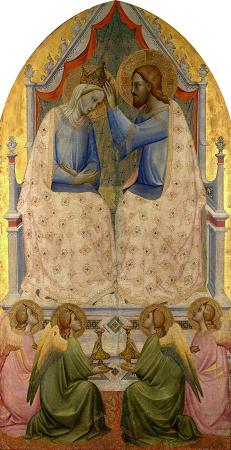Coronation of Virgin. The Coronation of the Virgin or Coronation of Mary is a subject in Christian art, especially popular in Italy in the 13th to 15th centuries, but continuing in popularity until the 18th century and beyond. Christ, sometimes accompanied by God the Father and the Holy Spirit in the form of a dove, places a crown on the head of Mary as Queen of Heaven. In early versions the setting is a Heaven imagined as an earthly court, staffed by saints and angels; in later versions Heaven is more often seen as in the sky, with the figures seated on clouds. The subject is also notable as one where the whole Christian Trinity is often shown together, sometimes in unusual ways. Although crowned Virgins may be seen in Orthodox Christian icons, the coronation by the deity is not. Mary is sometimes shown, in both Eastern and Western Christian art, being crowned by one or two angels, but this is considered a different subject. The subject became common as part of a general increase in devotion to Mary in the Early Gothic period, and is one of the commonest subjects in surviving 14th-century Italian panel paintings, mostly made to go on a side-altar in a church. The great majority of Roman Catholic churches had a side-altar or Lady chapel dedicated to Mary. The subject is still often enacted in rituals or popular pageants called May crownings, although the crowning is performed by human figures. The belief in Mary as Queen of Heaven obtained the papal sanction of Pope Pius XII in his encyclical Ad Caeli Reginam of October 11, 1954. It is also the fifth Glorious Mystery of the Rosary. The Roman Catholic Church celebrates the feast every August 22, where it replaced the former octave of the Assumption of Mary in 1969, a move made by Pope Paul VI. The feast was formerly celebrated on May 31, at the end of the Marian month, where the present general calendar now commemorates the Feast of the Visitation. In addition, there are Canonical coronations authorized by the Pope which are given to specific Marian images venerated in a particular place. The Coronation of the Blessed Virgin Mary is the fifth of the Glorious Mysteries of the Rosary and therefore the idea that the Virgin Mother of God was physically crowned as Queen of Heaven after her Assumption is a traditional Catholic belief echoed in the Rosary. This belief is now represented in the liturgical feast of the Queenship of Mary, that follows closely after the solemnity of the Assumption. The scene is the final episode in the Life of the Virgin, and follows her Assumption-not yet dogma in the Middle Ages-or Dormition. The scriptural basis is found in the Song of Songs, Psalms and Revelation. A sermon wrongly believed to be by Saint Jerome elaborated on these and was used by standard medieval works such as the Golden Legend and other writers. The title Queen of Heaven, or Regina Coeli, for Mary goes back to at least the 12th century. The subject also drew from the idea of the Virgin as the throne of Solomon, that is the throne on which a Christ-child sits in a Madonna and Child. It was felt that the throne itself must be royal. In general the art of this period, often paid for by royalty and the nobility, increasingly regarded the heavenly court as a mirror of earthly ones. The subject seems to first appear in art, unusually, in England, where a tympanum over the door of the church at Quenington in Gloucestershire of perhaps 1140 may be the earliest surviving depiction, and there is another in Reading, Berkshire. It was rapidly adopted and is prominent in the portals of French Gothic cathedrals such as Laon, Notre-Dame de Paris, Amiens and Reims, indeed most 13th-century cathedrals in France.There are three examples extant on Devon roodscreen dados: at East Portlemouth, Holne, and Torbryan. In earlier versions, Mary and Christ often sit side by side on a wide throne, and typically are only accompanied by angels in smaller altarpieces, although these were often in polyptych form, and had saints on side-panels, now often separated. Later God the Father often sits beside Christ, with the Holy Spirit hovering between them, and Mary kneeling in front of them. Christ and God the Father are normally differentiated by age, and to some extent by costume, God the Father often wearing a beehive-shaped crown, reminiscent of a Papal tiara. By the 15th century some more individual interpretations are found. From the High Renaissance onwards the subject is often combined with an Assumption, by having a group of the Apostles on the ground below the heavenly scene.
more...














